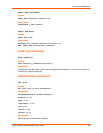
14: Command Reference
SLB™ Branch Office Manager User Guide 213
Table 14-1. Actions and Category Options
Action
Category
set
network | ipfilter | routing | datetime | ntp | services |
nfs | cifs | menu | auth | hostlist | localusers |
remoteusers | ldap | radius | kerberos | tacacs+ |
consoleport | deviceport | nis | slcnetwork | command |
sshkey | password | history | cli | locallog | power
show
network | ipfilter | routing | datetime | ntp | services |
nfs | cifs | menu | auth | hostlist | localusers | nis |
ldap | radius | kerberos | tacacs+ | consoleport |
deviceport | locallog | sysstatus | syslog | auditlog |
portstatus | sysconfig | portcounters | connections |
slcnetwork | sshkey | history | cli | user | remoteusers |
power
connect
direct | listen | bidirection | unidirection | terminate
diag
ping | loopback | traceroute | arp | lookup | netstat |
perfstat | sendpacket | nettrace | internals
pccard
storage | modem
admin
reboot | shutdown | ftp | config | firmware | version |
banner | keypad | quicksetup | web | events | lcd
logout
Terminates CLI session.
Command Line Help
For general Help and to display the commands to which you have rights, type:
help
For general command line Help, type:
help command line
For more information about a specific command, type help followed by the command,
for example:
help set network or help admin firmware
Tips
Type enough characters to identify the action, category, or parameter name uniquely.
For parameter values, type the entire value. For example, you can shorten:
set network port 1 state static ipaddr 122.3.10.1 mask
255.255.0.0
to
se net po 1 st static ip 122.3.10.1 ma 255.255.0.0
Use the Tab key to automatically complete action, category, or parameter names.
Type a partial name and press Tab either to complete the name if only one is
possible, or to display the possible names if more than one is possible. Following a
space after the preceding name, Tab displays all possible names.
Should you make a mistake while typing, backspace by pressing the Backspace key
and/or the Delete key, depending on how you accessed the interface. Both keys
work if you use VT100 emulation in your terminal access program when connecting
to the console port. Use the left and right arrow keys to move within a command.


















